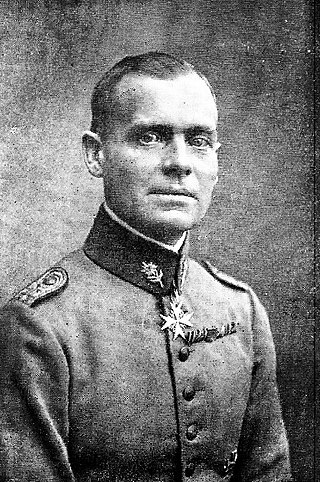
The 3rd Infantry Division was an infantry division of the German Army that fought in World War II. The division was established under the cover name Wehrgauleitung Frankfurt in 1934 by expanding the 3rd Division of the Reichswehr. It was redesignated Kommandant von Frankfurt shortly afterward, and took on its bona fide name when the formation of the Wehrmacht was announced in October 1935. In March 1939 the division took part in the invasion and occupation of Czechoslovakia.

Jakob Ritter von Danner was a Bavarian general in the Imperial German Army and the Reichswehr. As commandant of the Munich garrison of the Reichswehr, he was a central figure in putting down the attempted Beer Hall Putsch by Adolf Hitler and the Nazis in 1923.
The 21st Infantry Division was a German military unit which fought during World War II.

Heinrich Kirchheim was a German generalleutnant who served in both World War I and World War II. He is also one of few German officers who were awarded the Pour le Mérite and the Knight's Cross of the Iron Cross. He also served as a deputy member on the "Court of Military Honour," a drumhead court-martial that expelled many of the officers involved in the 20 July Plot from the Army before handing them over to the People's Court.

The 30th Infantry Division of the Wehrmacht was created on 1 October 1936 in Lübeck and mobilized on 26 August 1939 for the upcoming invasion of Poland. At that time, it consisted of the usual German infantry division elements: three infantry regiments of three battalions each, one three-battalion regiment of light artillery, one battalion of heavy artillery, a panzerjager (anti-tank) battalion, an aufklärungs (reconnaissance) battalion, a signals battalion, a pioneer (engineer) battalion, and divisional supply, medical, and administrative units.
The 5th Division was a unit of the Reichswehr.
The 2nd Division was a unit of the Reichswehr.
The 4th Division was a unit of the Reichswehr.
The 6th Division was a unit of the Reichswehr.
The 7th Division was a unit of the Reichswehr.
The 1st Cavalry Division was a unit of the Reichswehr, the armed forces of Germany during the Weimar Republic.
The 2nd Cavalry Division was a unit of the Reichswehr, the armed forces of Germany during the Weimar Republic.
The 3rd Cavalry Division was a unit of the Reichswehr, the armed forces of Germany during the Weimar Republic. It consisted of 6 cavalry regiments, the 13th (Prussian), 14th, 15th, 16th, 17th (Bavarian), and 18th (Saxon) Cavalry Regiments. It was subordinated to Gruppenkommando 2.
The 1st Division was a unit of the Reichswehr, the armed forces of Germany during the Weimar Republic.

The 15th Infantry Division was an infantry division of the German Army during the interwar period and World War II, active from 1934 to 1945.
Hans-Hellmuth Pfeifer was a German general during World War II. A veteran of World War I, he held higher command positions in WWII, among other, that of the 65th Infantry Division in Italy, selecting its hand grenade symbol which earned the nickname "The Hand Grenade Division."
Viktor von Schwedler was a general in the Wehrmacht of Nazi Germany who commanded an army corps and a military district during World War II. He was awarded the Knight's Cross of the Iron Cross.
Generalleutnant Walter von Hippel (Luftwaffe) (27 May 1897 – 29 November 1972) was a general in the Luftwaffe of Nazi Germany during World War II who commanded several flak divisions. He was also a recipient of the Knight's Cross of the Iron Cross.
The 290th Infantry Division was a German infantry division in World War II. It was formed in the Munster Training Area in Wehrkreis X on 6 February 1940 and surrendered to Soviet forces at the end of the war as part of Army Group Courland.
Erich Paul Weber was a German army officer, who served in both the German Imperial Army and the Ottoman Army during World War I, and ultimately attained the rank of General of Infantry.




